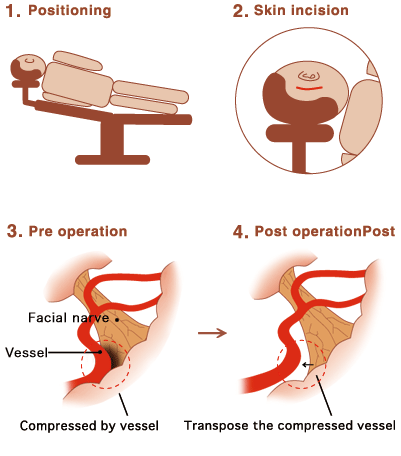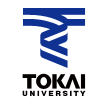- HOME
- For Patients
- Facial spasm and trigeminal neuralgia
- Treatments of facial spasm and trigeminal neuralgia
Facial spasm and trigeminal neuralgia
- Symptoms of facial spasm and trigeminal neuralgia
- Cause of facial spasm and trigeminal neuralgia
- Diagnosis of facial spasm and trigeminal neuralgia
- Treatments of facial spasm and trigeminal neuralgia
Treatments of facial spasm and trigeminal neuralgia
Facial Spasm
Surgery
Surgery is performed from behind the ear, using a microscope, to move the blood vessel causing the problem away from the nerve. If performed by an experienced neurosurgeon, this procedure almost never results in complications and directly removes the cause. Compared with the methods involving medication or injections described below, this method offers a more complete cure.
Medication
This involves taking oral medication, such as tranquilizers, to relieve psychological tension and muscle relaxants. If spasms are mild, they can be eased with oral medication.
Injections
In recent years, advances have been made in treatment using drugs to block communications between nerves and muscles. Such treatment involves injecting a special drug into the facial muscles that go into spasm, preventing nerve hyperactivity from being transmitted to these muscles.
Such treatment is initially effective, but spasms start up again after some time has passed and complete curative is therefore not achieved. Repeated injections are required every 3 months, and if spasms are repeated then eventually the nerves become paralyzed, in some cases preventing facial expression and causing saliva to drool from the mouth.
Trigeminal Neuralgia
Medication
Taking medication used to treat epilepsy can greatly alleviate symptoms. This is known to be effective insofar as it releases patients from severe pain.
Injections
Injection treatment involves anesthetizing the painful area. Several methods can be used to perform this "block treatment".
Can the underlying cause be cured by surgery?
As described above, treatment with oral medication or injections is not curative and does not solve the underlying cause. The severity of symptoms may be reduced, but the disorder is not cured.
The only treatment that can properly cure the underlying cause is surgery, but this is also the most physically taxing type of treatment. As described above, in almost all cases the cause is contact with (and pressure from) a nerve by a blood vessel at the point at which the nerve leaves or enters the brain. Direct observation and removal of this pressure results in the great majority of symptoms either disappearing or becoming much milder. This is true for both facial spasm and trigeminal neuralgia. Of course, if a brain tumor is responsible, then appropriate treatment methods must be considered.








